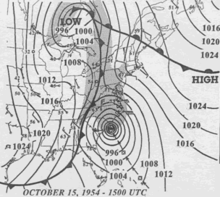
Back Huracà Hazel Catalan Uragano Hazel EO Huracán Hazel Spanish توفند هازل FA Hurrikaani Hazel Finnish Ouragan Hazel French Ураган Хејзел MK Huragan Hazel Polish Furacão Hazel Portuguese Hurricane Hazel SIMPLE
 Surface weather map of Hazel near landfall in North Carolina on October 15 | |
| Meteorological history | |
|---|---|
| Formed | October 5, 1954 |
| Extratropical | October 15, 1954 |
| Dissipated | October 18, 1954 |
| Category 4 major hurricane | |
| 1-minute sustained (SSHWS/NWS) | |
| Highest winds | 130 mph (215 km/h) |
| Lowest pressure | 938 mbar (hPa); 27.70 inHg |
| Overall effects | |
| Fatalities | 592–1,192 |
| Damage | $382 million (1954 USD) |
| Areas affected | Trinidad and Tobago, Lesser Antilles, Northern South America, Puerto Rico, Leeward Antilles, Jamaica, Hispaniola, Cuba, Lucayan Archipelago, East Coast of the United States, Ontario |
| IBTrACS | |
Part of the 1954 Atlantic hurricane season | |
Hurricane Hazel was the deadliest, second-costliest, and most intense hurricane of the 1954 Atlantic hurricane season. The storm killed at least 469 people in Haiti before it struck the United States near the border between North and South Carolina as a Category 4 hurricane. After causing 95 fatalities in the US, Hazel struck Canada as an extratropical storm, which raised the death toll by 81 people, mostly in Toronto. As a result of the high death toll and the damage caused by Hazel, its name was retired from use for North Atlantic hurricanes.
In Haiti, Hazel destroyed 40 percent of the coffee trees and 50 percent of the cacao crop, which affected the economy for several years. The hurricane made landfall near Calabash, North Carolina, and destroyed most waterfront dwellings. It then traveled north along the Atlantic coast. Hazel affected Virginia; Washington, D.C.; West Virginia; Maryland; Delaware; New Jersey; Pennsylvania; and New York. It brought gusts near 160 km/h (100 mph) and caused $281 million (1954 USD) in damage. When it was over Pennsylvania, Hazel consolidated with a cold front and turned northwest towards Canada. When it hit Ontario as an extratropical storm, rivers and streams in and around Toronto overflowed their banks, which caused severe flooding. As a result, many residential areas in the local floodplains, such as the Raymore Drive area, were subsequently converted to parkland. In Canada alone, over C$135 million (2023: C$1.5 billion) of damage was incurred.
The effects of Hazel were particularly unprecedented in Toronto because of a combination of heavy rainfall during the preceding weeks, a lack of experience in dealing with hurricanes, and the storm's unexpected retention of power despite traveling 1,100 km (680 mi) over land. The storm stalled over the Toronto area, and although it was now extratropical, it remained as powerful as a category 1 hurricane. To help with the cleanup, 800 members of the military were summoned, and a Hurricane Relief Fund was established that distributed $5.1 million (2023: $57.9 million) in aid.